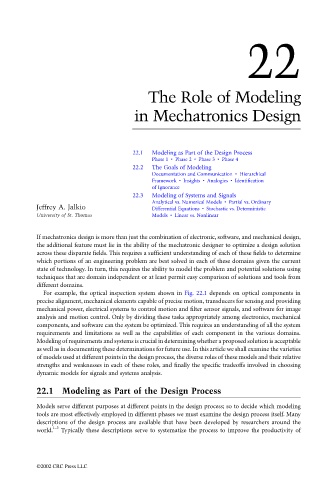Page 682 - The Mechatronics Handbook
P. 682
22
The Role of Modeling
in Mechatronics Design
22.1 Modeling as Part of the Design Process
Phase 1 • Phase 2 • Phase 3 • Phase 4
22.2 The Goals of Modeling
Documentation and Communication • Hierarchical
Framework • Insights • Analogies • Identification
of Ignorance
22.3 Modeling of Systems and Signals
Analytical vs. Numerical Models • Partial vs. Ordinary
Jeffrey A. Jalkio Differential Equations • Stochastic vs. Deterministic
University of St. Thomas Models • Linear vs. Nonlinear
If mechatronics design is more than just the combination of electronic, software, and mechanical design,
the additional feature must lie in the ability of the mechatronic designer to optimize a design solution
across these disparate fields. This requires a sufficient understanding of each of these fields to determine
which portions of an engineering problem are best solved in each of these domains given the current
state of technology. In turn, this requires the ability to model the problem and potential solutions using
techniques that are domain independent or at least permit easy comparison of solutions and tools from
different domains.
For example, the optical inspection system shown in Fig. 22.1 depends on optical components in
precise alignment, mechanical elements capable of precise motion, transducers for sensing and providing
mechanical power, electrical systems to control motion and filter sensor signals, and software for image
analysis and motion control. Only by dividing these tasks appropriately among electronics, mechanical
components, and software can the system be optimized. This requires an understanding of all the system
requirements and limitations as well as the capabilities of each component in the various domains.
Modeling of requirements and systems is crucial in determining whether a proposed solution is acceptable
as well as in documenting these determinations for future use. In this article we shall examine the varieties
of models used at different points in the design process, the diverse roles of these models and their relative
strengths and weaknesses in each of these roles, and finally the specific tradeoffs involved in choosing
dynamic models for signals and systems analysis.
22.1 Modeling as Part of the Design Process
Models serve different purposes at different points in the design process; so to decide which modeling
tools are most effectively employed in different phases we must examine the design process itself. Many
descriptions of the design process are available that have been developed by researchers around the
1–3
world. Typically these descriptions serve to systematize the process to improve the productivity of
©2002 CRC Press LLC

